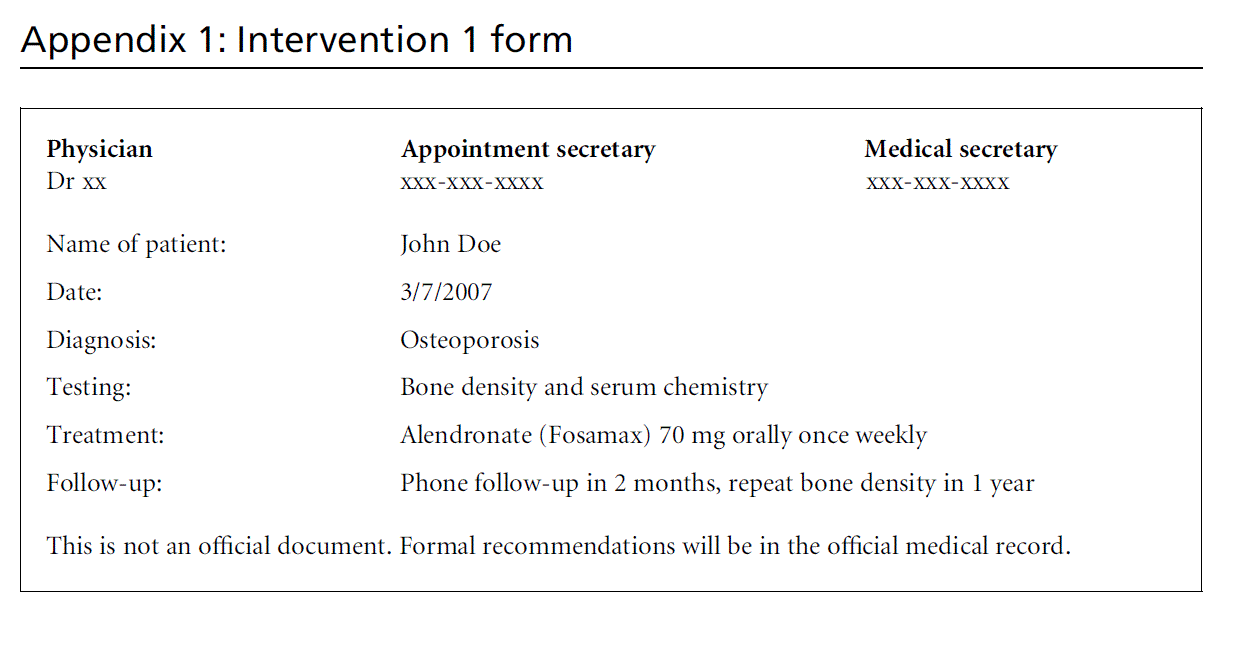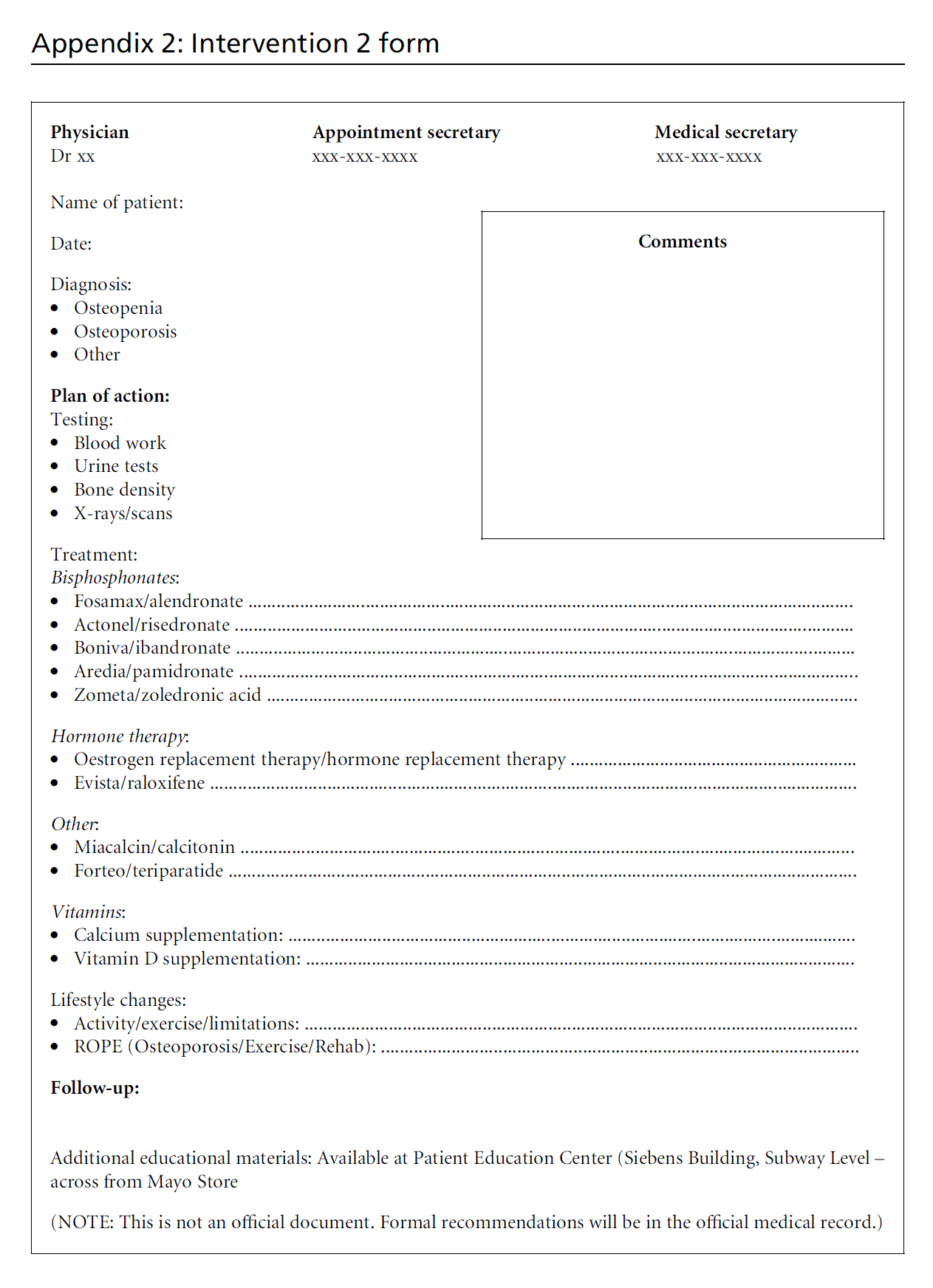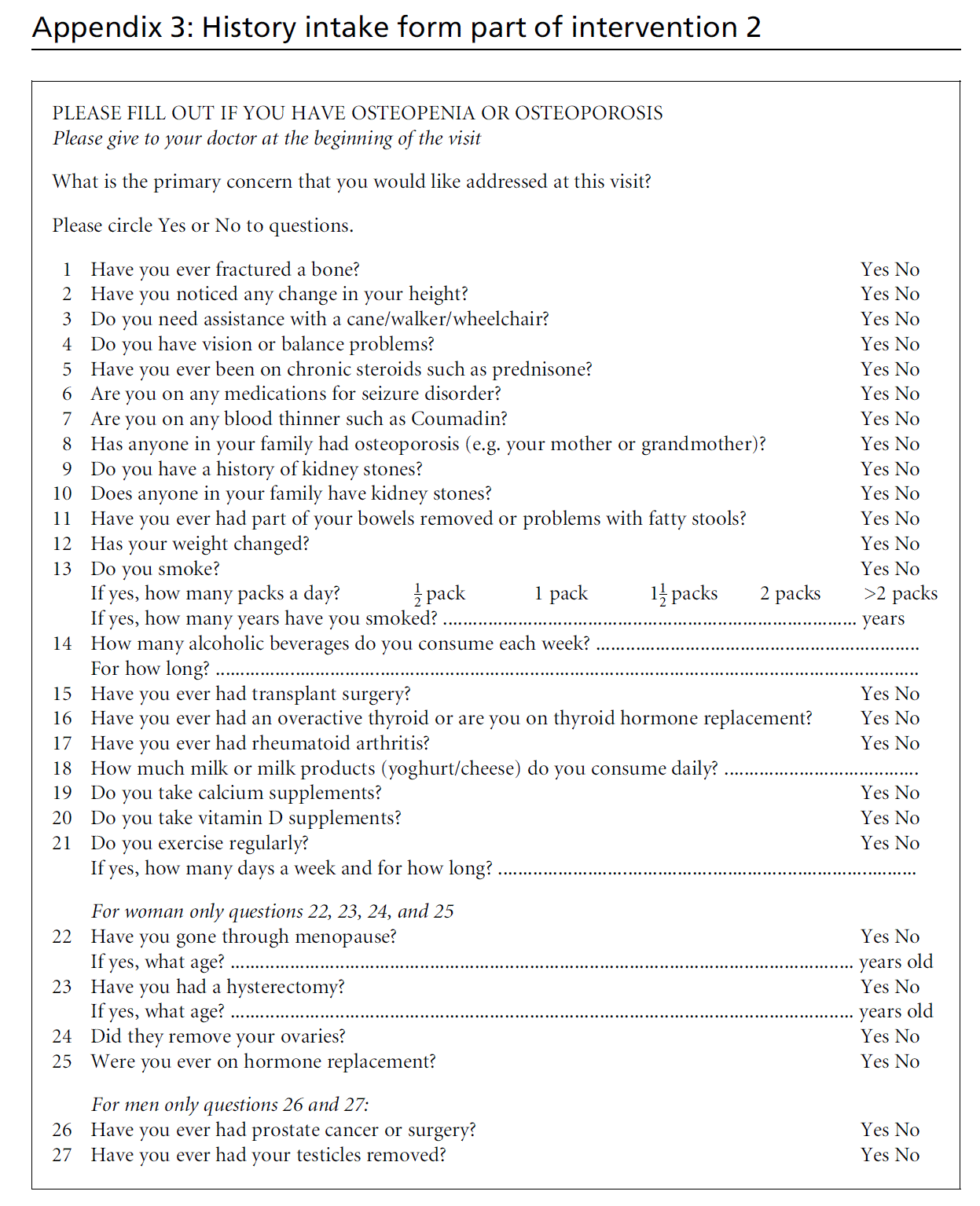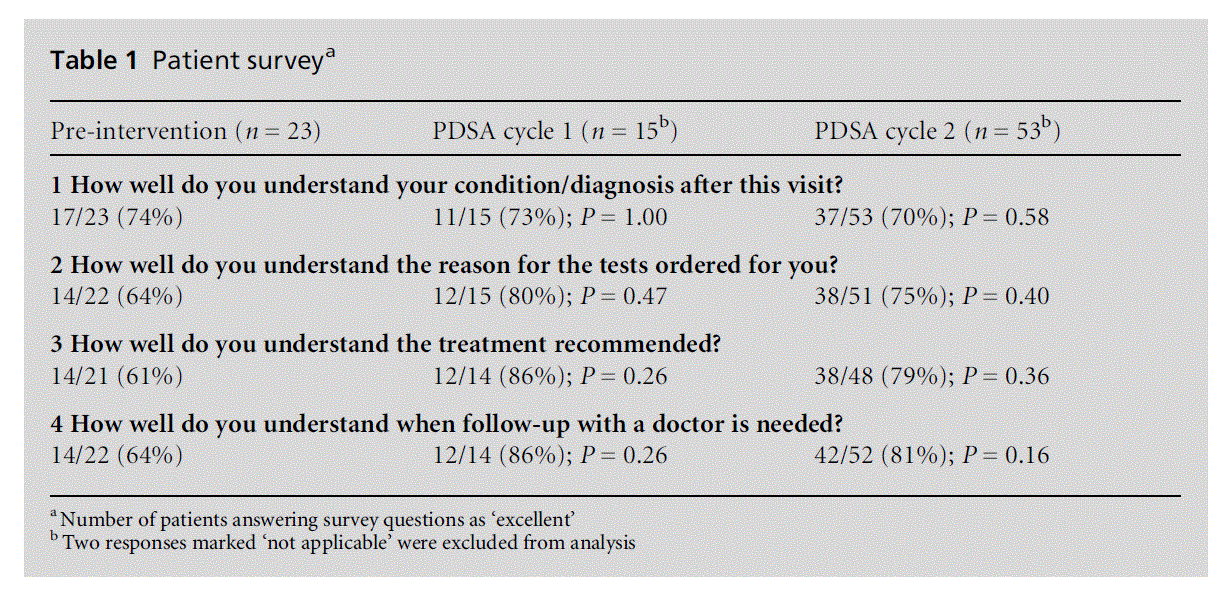Quality Improvement Report - (2009) Volume 17, Issue 3
1Associate Professor of Medicine, Division of Preventive and Occupational Medicine
2Fellow, Division of Endocrinology
3Fellow, Division of Endocrinology
4Fellow, Division of Endocrinology Mayo Clinic College of Medicine, Rochester, MN, USA
5PhD Candidate in Epidemiology, Department of Health Science, Shiga University of Medical Science, Japan
6Private Practice, San Jose´ , CA, USA
7Assistant Professor of Medicine, Division of Preventive and Occupational Medicine, Mayo Clinic College of Medicine, Rochester, MN, USA
Received date:30 July 2008; Accepted date: 6 April 2009
Background Patients recall less than half the information provided to them by their physicians. Aims The aim of this study was to use qualityimprovement (QI) techniques to enhance patient understanding of diagnosis, management and followup at the end of the office visit. Method QI techniques including stakeholder analysis, processmapping and plan-do-study-act (PDSA) cycles were used in a pilot study in an outpatient endocrinology clinic specialising in bone disease. The impact of these interventions was evaluated by pre- and post-intervention patient surveys that included qualitative and quantitative data. Results A team of endocrinology fellows and faculty with expertise in QI developed a series of tools to encourage conversation and interaction during the encounter and to serve as a reference for patients to take home through five PDSA cycles. The tools were iterations of written materials provided to patients at the end of the clinical encounter. In each cycle, the tools were modified according to feedback from patients and providers. Ninety-three patients participated in this study. Patients were surveyed after the implementation of two of the five cycles. Compared with pre-intervention, modifications during the two cycles were associated with a non-significant increase in patients’ understanding of the reasons for testing (from 64% to 80% and 75%); management plan (from 61% to 86% and 79%); and future follow-up plans (from 64% to 86% and 81%); P > 0.05 for all three outcomes. Improvement was not seen in patients’ knowledgeof their diagnoses (from 74% to 73% and 70%; P > 0.05). Conclusion This pilot study shows how QI tools can be used for creating and initiating system improvements aimed at enhancing patient education and counselling.
patient counselling, patient education, plan-do-study-act, quality improvement
Physicians commonly overestimate the level of patient literacy.[1] Despite spending a significant amount of time discussing the diagnosis and management with patients, it is unclear if physicians effectively counsel patients so that they understand, recall and implement physician recommendations. The lack of adequate informationflowmaylead tomedical errors, suboptimal outcomes, low patient satisfaction, unanticipated visits and decreased provider satisfaction.
User-friendly, up-to-date, expert-approved information provided to the patient at the end of the outpatient visit has been proposed as a solution to this problem.[2] However, the optimal content and content-delivery medium to enhance effective patient– physician communication are unknown. Moreover, ‘optimal’ for different individuals may differ based on their educational and cultural background, learning style or preference. When patients visit healthcare providers the interaction is typically characterised by verbal delivery of information by the provider to the patient, often containing technical words that the patient may not understand. Similarly, healthcare providers frequently overestimate patients’ literacy levels and patients themselves may be too embarrassed to ask for clarification when given medical information they do not comprehend. Blalock et al reported that 63.7%of patients who had received osteoporosisprevention counselling did not remember receiving it, suggesting that counselling was suboptimal and insufficient to promote subsequent recall and behavioural change.[3] This is, unfortunately, not an uncommon occurrence.
QI techniques are increasingly being recommended for efficient systems improvement in patient education and counselling.[4–7] As opposed to traditional research, QI techniques often use input frommultiple stakeholders to redesign systems for solving complex problems. In addition, these techniques facilitate the testing of multiple strategies over a short period of time. There is no published literature on QI methodologies and processes used for the development of tools for enhanced patient–physician communication. This manuscript describes a QI pilot study conducted with the goal of enhancing patient understanding of their diagnosis and management plan at the end of the office visit. We hope that the techniques used to generate the results of this study will lay the foundation for future work in the area of QI and patient education
Impetus
The impetus to this study was a patient survey conducted in our institution with the aim of evaluating patients’ satisfaction with care. This survey is conducted quarterly by a market research company specialising in patient satisfaction. A random sample of patients with recent outpatient visits is contacted via phone by company representatives. Five attempts are made to contact each patient, which usually generates a high response rate. Results specific to the division of endocrinology in 2007 showed that although patients rated their providers’ knowledge highly for efficiency, expertise and overall quality of care, only 58.1% (43/ 74) of patients surveyed rated as excellent (the highest rating) the provision of ‘clear explanation of [your] condition and treatment and what to expect’, and only 49.3% (36/73) of patients rated as excellent ‘clear instructions ofwhat to do following the appointment’. In an effort to enhance patient understanding of the diagnosis and management plan at the end of the office visit, we decided to explore the use of quality improvement (QI) techniques to address the issue.
This study was conducted at the Bone Clinic, a section of the Division of Endocrinology at the Mayo Clinic, Rochester. This is an outpatient clinic located in a larger tertiary care centre specialising in the evaluation and management of metabolic bone disease and staffed by endocrinology fellows and faculty. Most of the patients present with diagnoses of osteopenia, osteoporosis, or parathyroid disease. The majority of patients are females (76%) and aged between 50 and 79 years (69%). Patients are referred to this clinic by their primary care physicians or physicians in other specialties.
This study was approved by the institutional review board. Detailed process mapping was conducted as a first step to understanding information flow at the bone clinic.[8] Observers took field notes and photographs, and conducted interviews of faculty physicians, residents and patients. Discrepancies between what the patient heard and what they understood were noted. It was especially noted that although patients received mailed summary letters of their diagnoses and treatment plans within two weeks of the visit, they wished for similar concise material to be provided at the end of the visit. Subsequently, stakeholders were identified to be patients, physicians, clinical assistants, nurses, and receptionists as well as other people who are less directly involved in the clinical encounter (i.e. administrators, finance and insurance specialists).
Using rapid cycle improvement methods,[9] a series of interventional tools was developed, implemented and modified over a three-week period based on feedback from patients and providers. This method involves a ‘trial-and learning’ approach where a hypothesis or suggested solution for improvement is made, and testing is carried out on a small scale before any changes are made to the whole system. In this case, the hypothesis was that patients were receiving sufficient education and counselling but the volume of information was overwhelming and delivered orally or in a pre-printed format, which was not specific to the individual patient. Thus, the team proposed that a written tool specific to an individual patient should be developed and discussed during the clinical encounter, then handed to the patient so he/she can refer to this tool at home. A sequence of four steps of ‘plan-dostudy- act’ (PDSA) was carried out in repeated small cycles, which is designed to lead to improvements.
Whenever significant changes were made in each cycle, a paper-and-pen survey was conducted. In these surveys, patients graded their understanding of the condition/diagnosis, reasons for tests ordered, treatment and follow-up appointments, on a five-point Likert scale (1 = excellent, 2 = very good, 3 = good, 4 = fair, 5 = poor) at the conclusion of their outpatient appointment. This pre- and post-evaluation tool was developed by the QI team and corresponded to questions identified on the initial satisfaction survey that gave the impetus to this QI project. The team made changes to the evaluation tool to adapt it to the changing nature of the intervention as it went through successive PDSA cycles, and as a result decided to develop and modify a bespoke tool rather than using an existing tool. Responses were dichotomised into ‘excellent’ and ‘less than excellent’ for purposes of analysis. Questions marked with ‘not applicable’ were excluded from analysis. The Fisher exact test was used determine the statistical significance of the changes in proportions considering a two-tailed P value of <0.05 to be significant.
During the 3-week period of this QI project, the team used feedback from patients and providers to quickly modify the educational tool, and thus conducted five rapid cycles of improvement of the tool. Patients’ surveys to evaluate the tool were conducted after the second and fifth PDSA cycles, the two cycles that carried most changes from previous attempts. We called these two PDSA cycles intervention 1 and 2, respectively.
The first PDSA cycle included an information sheet in which the name of the provider, diagnosis, and plan of action could be outlined by the provider (see Appendix 1). In the next iteration of this cycle (intervention 1), this form was modified to include providers’ names and their contact information as well as a carbon copy for ease of dictation into the medical record. By the end of this cycle, providers recommended enhancing the forms to include a higher number of pre-filled areas since most patients had a diagnosis of osteopenia or osteoporosis and would probably require similar instructions.

In the second PDSA cycle, the formwas modified to include check boxes for diagnosis and testing and treatment categories common to osteoporosis and osteopenia (see Appendix 2). The physician was expected to fill in the recommendations for calcium intake, physical activity and follow-up. Similarly, an ‘educational materials’ check-box section was incorporated allowing physicians to select which prepared educational materials would be most helpful for the patient. Based on feedback from patients and providers that detailed listing of patient educational materials was not being utilised effectively, the form was modified in the next iteration to simply mention the Mayo Patient Education Center as a patient resource centre. Finally, an additional form was given to patients in the waiting room to note their primary concerns for the visit. This allowed better agenda setting and established which outcomes for the visit were anticipated by patients. This form was subsequently enhanced to include some of the common questions physicians asked patients with suspected bone disease, aiming at enhancing efficiency of the visit to allow more counselling time (see Appendix 3). Lastly, in the final iteration of this tool (intervention 2), we added more check-box items to make the process easier for providers, and a print-out of laboratory and imaging studies for patients to keep.


Ninety-three patients participated in this study. Twentythree patients were surveyed before implementation of QI measures to obtain baseline data. Seventy patients were surveyed during all the PDSA cycles described above. Seven endocrinologists and three endocrinology fellows formed the participating provider team. The length of time spent with their provider was perceived as being adequate by most patients before (22 of 23; 95.6%) and after implementation of interventions (64 of 66; 97%). The majority of patients (89%, 17 of 19) indicated that they did not wish for additional information about their condition or more handouts; however, they requested hard copies of laboratory and imaging results.
Compared with pre-intervention, the implementation of the two interventions was associated with a non-significant increase in patients’ understanding of the reasons for testing, management plan and future follow-up. This improvement was not noted for patients’ knowledge of their diagnoses. Results are depicted in Table 1.

Some notable excerpts fromthe free-text comments section of the patient survey included:
‘I know what to expect after this visit.’
‘[I am] confident that I can communicate the doctor’s recommendations to my husband.’
Physician feedback comments included:
‘[This] sets the stage for effective and objective communication.’
‘If these interventions ultimately affect outcomes by improving compliance through better understanding, I am willing to incorporate them in my practice.’
Patients recall less than half the amount of information provided to them by their physicians. Nonretention of critical information may be associated with worse patient outcomes. Patients who are able to recall information given by healthcare providers exhibit improvement in clinical measures of disease activity and control.[10,11] In this report, we describe the use of the PDSA methodology to develop and implement an intervention aimed at creating a physicianand patient-friendly written summary document that included diagnosis, medication list and follow-up instructions that could be provided to patients at the end of the outpatient visit. The PDSA methodology proved to be efficient, feasible and acceptable for creating, implementing and studying the effects of an optimal patient education tool in a total of three weeks.
Throughout this study, it was consistently noted that providing written information in the outpatient setting (akin to a hospital discharge summary) provided a concise summary of the diagnosis and management plan which patients could use as a reference point for clarifications and discussions with their loved ones. While many patients did not want additional handouts, they probably selected materials such as laboratory and imaging results as well as a written list of diagnosis, summary recommendations and followup instructions. Physicians annotated and highlighted the areas they considered most critical for the health of each patient, and provided the patients with copies of their laboratory and imaging results. We concluded that individualised documented information provided to the patient at the end of the visit enhanced patient satisfaction with the physician–patient communication. The written component (in addition to the verbal element present in most physician–patient communications) probably enhanced the understanding of the relayed information, as technical results and diagnoses may be difficult to remember because of unfamiliarity to most patients. It was also likely that a written aid enhanced recall of physician–patient discussions, especially when several issues were discussed in the course of the visit. There was, as expected, a lower patient rating of the usefulness of pre-visit collection of information as this intervention was geared primarily towards improving provider efficiency at collecting information during the visit. Interviews with the providers who implemented these interventions provided positive feedback regarding the usefulness of the same.
Other opportunities for improvement include the configuration of an interface to populate an outpatient visit summary from data available in the electronic medical chart, and posting such information on a secured link for patients to retrieve, for example, a patient portal.
Although we did not study the effect of our interventions on patient outcomes, others have evaluated the effectiveness of educational interventions on outcomes for osteoporosis/osteopenia. Jamal et al demonstrated that osteoporosis education in a written format along with results of bone mineral density testing improved calcium intake, as well as reduced smoking and intake of alcoholic and caffeinated beverages among study patients.[12] Audiotapes, videotapes, personal computers, and audio-guided booklets have also been used to improve evidence-based decision making in the management of osteoporosis/osteopenia, and have been shown to enhance physician–patient communication.[13–15]
The PDSA methodology provided an opportunity for stakeholders involved in the clinical encounter (including patients, physicians, clinical assistants, nurses and receptionists) to be fully engaged in developing an adequate tool for end-of-visit patient counselling and education whereby multiple iterations were tested and evaluated in a relatively short time. Other advantages of the PDSA methodology included making processes of improvement explicit, promoting teamwork, customising changes to local conditions, evaluating ‘sideeffects’ of an intervention quickly, and reducing risks. Possible disadvantages included difficulty in applying the method to large numbers and the difficulty of allowing adequate time for learning. Other tools such as ‘lean’, or ‘six sigma’ have also been used for standardisation of practices and elimination of errors.[9]
There are several limitations to this study. This pilot was viewed from its inception as a QI project to gather information about methods to enhance patient satisfaction regarding their diagnosis, treatment and follow- up plans rather than to test a hypothesis. We used a pre/post-intervention study design without a control group, patients were not randomised, and blinding was not performed to ascertain biases in the study. In addition, our PDSA method used small sample size for each of the interventions, which did not allow for meaningful statistical comparison of pre- and postintervention data. Finally, the use of ‘excellent’ as a goal for patient rating of satisfaction and a measure of performance is congruent with the modern concepts of QI and allows comparison with best practice rather than minimal standards.[8,9,16] One of the challenges that faced the team from the start of this pilot project was the high number of patients who rated their knowledge as excellent at baseline.
QI tools, such as the PDSA methods, are feasible and acceptable techniques for creating and initiating system improvements aimed at enhancing patient education and counselling. A written or printed sheet or memory-aid, with individualised information provided to the patient at the end of the visit helped enhance patient recall and satisfaction. Future studies with a larger sample size and more rigorous designs are needed to assess the benefit of such interventions on patient outcomes, clinician efficiency and costeffectiveness.
Neena Natt, MD and Todd Nippoldt, MD and Christian Milaster.
At the time of the study, Akira Fujiyoshi was a Preventive Medicine Fellow of Mayo Clinic College of Medicine, USA and Andrea Tom was an Endocrinology Fellow of Mayo Clinic College of Medicine, USA.
Mayo Clinic Institutional Review Board.
Not commissioned; externally Peer Reviewed.
None.